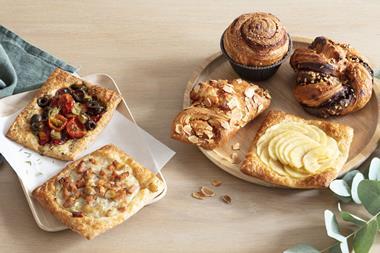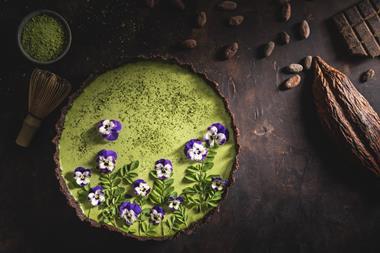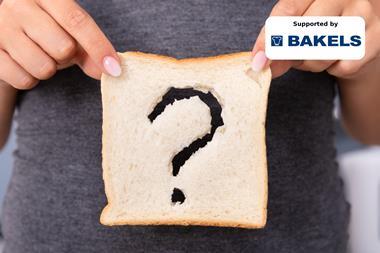With summer on its way, an emerging and innovative market for ice-cream sandwiches gives bakers plenty of scope to experiment and add value.
Why settle for one dessert when you can have two? That’s exactly what ice-cream sandwiches deliver.
Devised in 1899 by a street peddler, who sold ice-cream between two thin graham wafers, the ice-cream sandwich solved three core problems at the heart of early frozen dairy consumption: portability, temperature – with the consumer’s hand heat softening up the icy centre – and hygiene.
Today ice-cream sandwiches offer more than practicality, serving up indulgence, diverse flavours and textures.
For bakers, it’s a chance to add value to ranges, stand out from the crowd and tap into the UK’s growing ice cream market, which Mintel estimates is worth £1bn.
“The influence of the trend for multi-sensory ‘Café Gourmand’ creations shows customers are willing to pay more for stylish on-trend desserts,” suggests Michele Stanco, training and development chef at ice cream equipment manufacturer Carpigiani UK.
The days of the humble wafer are long gone: workable options for ice-cream sandwich ‘bread’ now go as far afield as churros and bao buns.
Anything with “a bit of give and not too coarse a crumb, so that it doesn’t fall apart” has potential, according to Ahrash Akbari-Kalhur, a founder of Chin Chin Ice-Cream, which sells desserts across two sites and a street stall in central London. The retailer’s decadent sarnies are topped with delicate morsels such as toasted marshmallow and porcini mushroom crumble, while the firm’s ‘crack’ – a molten shell of vegan chocolate – envelops a single scoop of ice cream.
Additionally, Chin Chin Ice-Cream has moulded goods ranging from choux pastry to vegan brownies into its cases. And when it comes to toppings, its pistachio cardamom powder and fleur de sel caramel options, in particular, straddle the delicate place between traditional and eclectic.
“People will pay a premium for ice cream in place of cream or crème patissière,” says Akbari-Kalhur. “But be aware that it’s more labour-intensive, and not all cakes and bakes work well frozen.”
When it comes to selling ice-cream sandwiches, there are plenty of practical considerations, says Akbari-Kalhur, including consistent display freezer temperature, a good amount of overrun – the amount of air pushed into the ice
cream being made – and high fat and sugar content to prevent the cake from over-freezing.
Chin Chin Ice-Cream will be releasing its own brioche con gelato – a classic Sicilian breakfast – in the summer, and also predicts that “pillowy” Japanese bread and bao buns will be huge on the gelato sandwich scene this summer.
Meanwhile, tapping into the trend for artisan bakes, Chinatown bakery Yolkin sells organic ice-cream sandwiched between handmade macaron shells. Flavours include yuzu and Earl Grey, and the photogenic nature of its creations has helped the firm become an Instagram hit.
“We use the French macaron method, tweaked so that our shells are edible from frozen,” says Sammie Le, founder of Yolkin. Her sarnies are both whimsical and visually striking; for Easter, Yolkin sold chick macaron shells containing a coconut ice-cream flavoured with a vivid yellow sorbet ‘yolk’.
Yolkin is testament to how bakers can leverage the visual appeal of ice-cream sandwiches to their advantage.
“Customers buy with their eyes first, and as ice-cream cakes are such a visible product, it’s worth displaying them in a gelato display case,” says Stanco, adding this can create a “considerable uplift” in sales.
Clockwise from left: Yolkin’s ice-cream sandwiches; a doughnut sandwich from Bird’s; and, Chin Chin Ice-Cream’s pistachio bun.
Exploring exotic flavours
While traditional ice-cream flavour stalwarts vanilla and chocolate continue to be popular, the gelato sandwich scene can appeal to experimental consumers; an audience hungry for exotic flavours and unusual combinations.
“Having a good selection of traditional favourites and also those with a point of difference will ensure all customers are satisfied,” says Christina Veal, director at New Forest Ice Cream.
Curious flavours from far-off lands have always been popular with adventurous buyers, and recently a trend toward Asian tastes has emerged.
“Japanese flavours have made their way onto restaurant menus with desserts such as mochi ice cream,” commented Michael Schofield from Bakels. “Furthermore, more developed options such as gulab jamun (syrup-flavoured milk solids), with additional green cardamom and rose water, kewra or saffron) and traditional Indian ice-cream kulfi can appeal to the adventurous consumer.”
Chinatown macaron-gelato bakery Yolkin serves south-east Asian flavours with a western twist, such as matcha and Oreo.
“We’ve seen an increase in flavours from the south east making a debut in the dessert scene,” says founder Sammie Le. “Red bean, ube (purple yam) and pandan (a fragrant tropical herb) have started to gain more popularity than ever before.”
Meanwhile, Ahrash Akbari-Kalhur from London nitro-ice-cream business Chin Chin believes in the power of pandan, as well as black sesame and Asian citrus fruit yuzu. He predicts that ice-cream cakes – rather than sandwiches – will increase in popularity.
Another flavour trend, says Veal, is deconstructed desserts, such as recreating popular desserts in an ice-cream format. New Forest’s “nostalgic” peach melba flavour features clotted cream, raspberry pieces and a peach ripple.
There has also been a subtle shift in traditional flavours. “Chefs are experimenting with the effect of chocolates from different origins on the taste of their desserts,” continues Schofield.
Alcohol is also proving popular, with artisan bakers exploring the flavour infusions of wines, beers and spirits to create multi-textured desserts.
“The trend for boozy ice cream and sorbets has taken off in recent years because it’s a great balance between satisfying a sweet craving and having a refreshing beverage or cocktail,” comments Veal. “Including ice cream and sorbets infused with alcohol means customers don’t have to choose between the two, and can enjoy the best of both worlds.”


























No comments yet